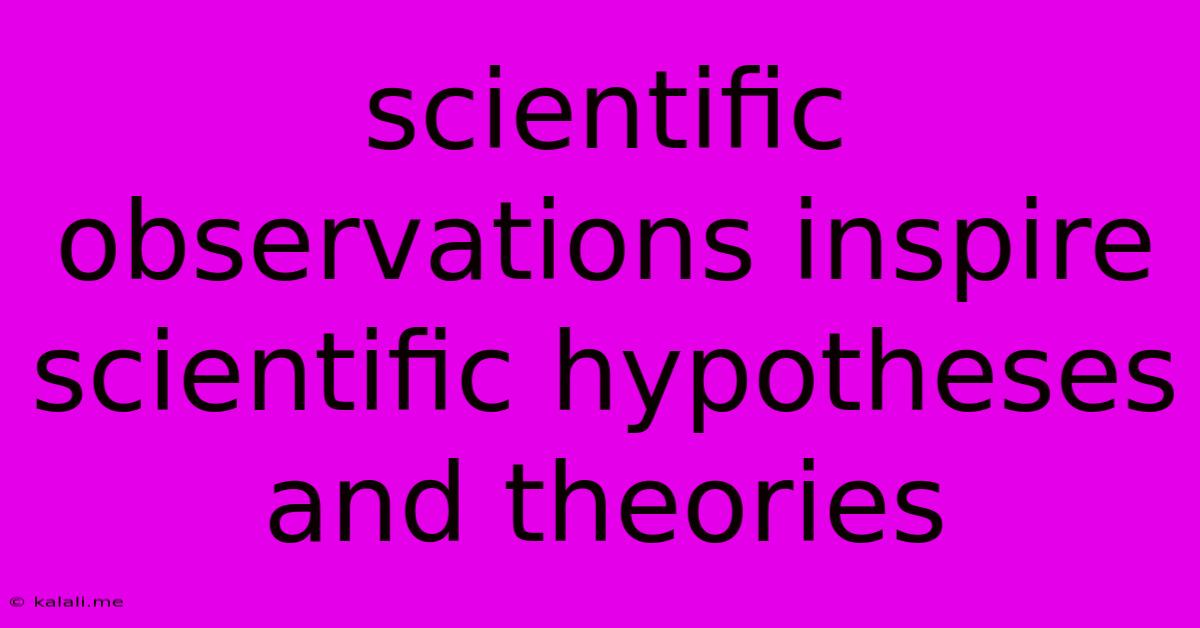Scientific Observations Inspire Scientific Hypotheses And Theories
Kalali
May 10, 2025 · 3 min read

Table of Contents
Scientific Observations Inspire Scientific Hypotheses and Theories
Meta Description: Discover how scientific observation, the foundation of scientific inquiry, leads to the formulation of hypotheses and ultimately, robust scientific theories. Learn about the crucial role of observation in driving scientific progress.
The scientific method, a cornerstone of modern science, hinges on a simple yet powerful process: observation. It's the meticulous act of noticing and recording phenomena in the natural world that sparks the entire scientific endeavor. This article will explore the fundamental connection between scientific observation, the formulation of hypotheses, and the eventual development of comprehensive scientific theories. We will see how keen observation, coupled with critical thinking, fuels the advancement of knowledge and understanding.
The Genesis of Inquiry: Making Observations
Scientific observation isn't merely casual looking; it's a systematic and detailed examination of the world around us. This involves utilizing various tools and techniques, from simple visual inspections to sophisticated instruments like microscopes and telescopes, to gather data. The more precise and thorough the observations, the more reliable the conclusions drawn from them. Examples abound: Charles Darwin's meticulous observations of finches on the Galapagos Islands, Galileo Galilei's telescopic observations of celestial bodies, and Gregor Mendel's painstaking observation of pea plant characteristics all laid the groundwork for revolutionary scientific breakthroughs. These observations weren't just passive; they involved careful measurement, data recording, and a systematic approach to gathering information. This systematic approach is crucial for eliminating bias and ensuring the reliability of findings.
From Observation to Hypothesis: Formulating Testable Explanations
Observations, however meticulous, are just the beginning. The next crucial step involves formulating a hypothesis – a tentative explanation for the observed phenomenon. A strong hypothesis is not merely a guess; it's a testable statement that proposes a cause-and-effect relationship. It must be falsifiable, meaning it's possible to design an experiment that could disprove it. This crucial aspect ensures that scientific hypotheses are subject to rigorous scrutiny. For instance, observing that plants grow taller in sunlight might lead to the hypothesis: "Plants exposed to sunlight will exhibit greater growth than plants kept in darkness." This hypothesis is testable through controlled experiments. The development of a robust hypothesis is a critical bridge between observation and experimentation.
Testing and Refining: The Role of Experiments and Data Analysis
Once a hypothesis is formulated, scientists design experiments to test its validity. Experiments carefully manipulate variables to isolate the effect of specific factors, while keeping other variables constant. The results of these experiments generate more data, which are then analyzed to determine whether the data support or refute the hypothesis. Crucially, scientific observations are never interpreted in isolation; they must be subjected to rigorous analysis within a broader framework of existing knowledge. Statistical analysis plays a vital role in interpreting data and determining the level of confidence one can have in the results. The iterative process of observation, hypothesis formation, experimentation, and analysis forms the core of the scientific method.
Building Theories: Integrating Evidence and Explanations
When a hypothesis repeatedly withstands rigorous testing and is supported by a substantial body of evidence from multiple independent studies, it can eventually evolve into a scientific theory. A scientific theory is not simply a guess or speculation; it's a well-substantiated explanation of some aspect of the natural world. It's a comprehensive framework that integrates numerous observations and experimental findings, offering a cohesive explanation for a wide range of phenomena. Theories like the theory of evolution by natural selection and the theory of general relativity are prime examples of robust scientific theories that have withstood decades of rigorous testing and refinement. However, it's important to note that scientific theories are not immutable; they are subject to revision or even replacement if new evidence emerges that contradicts existing explanations.
In conclusion, the relationship between scientific observation, hypothesis formation, and theory development is a dynamic and iterative process. It's a journey of continuous exploration and refinement driven by the meticulous observation of the natural world. The quest for understanding nature relies heavily on the interplay of these elements, leading to the progressive advancement of scientific knowledge.
Latest Posts
Latest Posts
-
How Many Square Yards In One Acre
Jul 02, 2025
-
What Is 2 3 Of 3 Quarts
Jul 02, 2025
-
Courtesy Is Cumbersome To Them That Know It Not
Jul 02, 2025
-
How Far Is 220 Yards On A Track
Jul 02, 2025
-
What Is The Shortest Chapter In The Bible
Jul 02, 2025
Related Post
Thank you for visiting our website which covers about Scientific Observations Inspire Scientific Hypotheses And Theories . We hope the information provided has been useful to you. Feel free to contact us if you have any questions or need further assistance. See you next time and don't miss to bookmark.